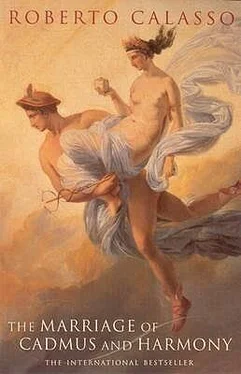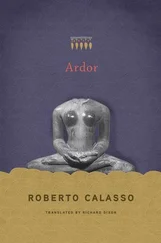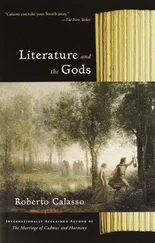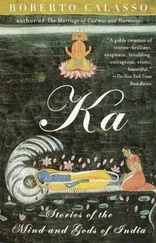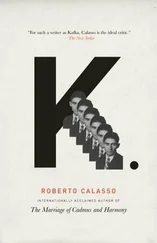Roberto Calasso - The Marriage of Cadmus and Harmony
Здесь есть возможность читать онлайн «Roberto Calasso - The Marriage of Cadmus and Harmony» весь текст электронной книги совершенно бесплатно (целиком полную версию без сокращений). В некоторых случаях можно слушать аудио, скачать через торрент в формате fb2 и присутствует краткое содержание. Год выпуска: 1993, Издательство: Alfred A. Knopf Inc, Жанр: Современная проза, на английском языке. Описание произведения, (предисловие) а так же отзывы посетителей доступны на портале библиотеки ЛибКат.
- Название:The Marriage of Cadmus and Harmony
- Автор:
- Издательство:Alfred A. Knopf Inc
- Жанр:
- Год:1993
- ISBN:нет данных
- Рейтинг книги:3 / 5. Голосов: 1
-
Избранное:Добавить в избранное
- Отзывы:
-
Ваша оценка:
- 60
- 1
- 2
- 3
- 4
- 5
The Marriage of Cadmus and Harmony: краткое содержание, описание и аннотация
Предлагаем к чтению аннотацию, описание, краткое содержание или предисловие (зависит от того, что написал сам автор книги «The Marriage of Cadmus and Harmony»). Если вы не нашли необходимую информацию о книге — напишите в комментариях, мы постараемся отыскать её.
The Marriage of Cadmus and Harmony — читать онлайн бесплатно полную книгу (весь текст) целиком
Ниже представлен текст книги, разбитый по страницам. Система сохранения места последней прочитанной страницы, позволяет с удобством читать онлайн бесплатно книгу «The Marriage of Cadmus and Harmony», без необходимости каждый раз заново искать на чём Вы остановились. Поставьте закладку, и сможете в любой момент перейти на страницу, на которой закончили чтение.
Интервал:
Закладка:
A swapping of bundles, an underground walk in the night, two little girls on their own: it was the enacting of a religious mystery. Thus the Athenians demonstrated under Athena’s glaucous gaze that they had not forgotten their sin. No one ever revealed what it was the Arrhephoroi carried and brought back on their heads. But more important than what was in the bundles was the fact that they should remain unopened, and that the two girls should move them in darkness.
After the ceremony, the girls were sent home. The following year two others would take their place. And one day they would all feel moved when they remembered the “splendid education” Athens had given them. The companions of Lysistrata recalled their girlhood thus: “At seven I was an Arrhephoros; at ten I was an aletrís , I ground the holy cakes in the service of our protectress; then I put on the saffron tunic and danced the bear dance at the Brauronia; and when I’d grown up to be a fine girl I was a basket bearer and wore a necklace of dried figs.” These girls had been through mystery the way other children cross a playground, and now, barricaded up on the Acropolis, they refused to let their coarse, lustful husbands so much as touch them.

Whatever happens in Athens, “splendor,” lamprótēs , always has a part to play. It was not because the tyranny of the sons of Pisistratus was unbearable that Harmodius and Aristogiton rebelled and thus became the model for all later reflections on conspiracies and tyrannicides. No, it was because Harmodius’s body was “in the splendor of youth,” and Hippias, Pisistratus’s son, desired him. But Aristogiton, an average citizen and Harmodius’s lover, also desired the boy. Their assassination attempt was motivated by “the pangs of love.”
And when the Athenians began flocking down to Piraeus at dawn on what they didn’t realize would be their last day of shared exhilaration albeit mixed with fear, when, that is, Alcibiades’ fleet set sail for Sicily — even on this occasion, in a scene colored by boldness, conquest, and death, the eye came to rest on “the splendor of the view” of those ships laden with ornaments, until the herald blew on his trumpet, silence fell, and the soldiers and commanders lifted their gold and silver cups to make a libation. So recounts Thucydides, most sober among Athenians.
Phye was a beautiful country girl, four cubits tall. She lived in the district of Paeania. When Pisistratus decided to return from exile and reestablish his tyranny, they went to find her. They dressed her in lavish armor and showed her how to stand and move so as to seem even more impressive. Then they got her to climb on a chariot and set off to Athens, preceded by a number of heralds. The heralds announced around the town that Pisistratus was returning and that the goddess Athena, who had always favored him, was leading him back to the Acropolis. “And convinced she was the goddess in person, the citizens worshiped a human creature and welcomed Pisistratus back.”
Herodotus claims that this piece of deception was “by far the most naive since the Hellenic race split off from the barbarians in ancient times, being shrewder and less prone to childish naïveté than they.” But, as always, it is the deception that reveals a truth which might otherwise escape us. This second return of Pisistratus happened in 541 B.C., just a few decades before Heraclitus began to write. And for all the extraordinary shrewdness they showed in their political struggles, the people of Athens were still willing to accept the possibility that one day the goddess Athena might ride into their city on a chariot.
It is easy to imagine the fate historians have reserved for what Gaetano De Sanctis refers to as “the absurd story of the shapely woman who, dressed up as Pallas, is supposed to have escorted Pisistratus into the city.” As we know, scholars have long been in the habit of pointing out the “childish naïveté” of Herodotus, just as he had pointed out the “childish naïveté” of the barbarians.
The fact remains, however, that Aristotle, who was to become the model of rational thought for every scholar of the classical world, tells the story of Pisistratus’s second return in exactly the same terms as Herodotus. Indeed, he even adds a few extra details about Phye, thus irritating Gaetano De Sanctis even more with this “worthless claptrap that demonstrates nothing but the poor historical sense of the author who collected it.” Aristotle writes: “Eleven years later, having been put in a difficult position by his own faction, Megacles opened negotiations with Pisistratus and, on the understanding that the latter would marry his daughter, had him return in a manner at once worthy of ancient times and extremely simple. He spread a rumor that Athena was leading Pisistratus back and, having found a tall and beautiful woman from the district of Paeania, as Herodotus says, or from the district of Collytus, as others claim, a flower seller of Thracian origin who went by the name of Phye, and having dressed her up to look like the goddess, he had her ride into the city at the tyrant’s side — thus Pisistratus entered the city on a chariot with the woman beside him, and the citizens bowed down in amazement and welcomed him.”
The most interesting thing about Aristotle’s account is his own comment on Pisistratus’s return, that it was “worthy of ancient times and extremely simple.” A century before him, Herodotus was still having to make an effort to exercise that marvelous new Greek quality, that shrewdness “alien to childish naïveté.” Hence he was obliged to present Pisistratus’s return as an almost unbelievable event.
The more sober Aristotle, by contrast, already had an entirely modern vision of events. Which is precisely why he was not in the least surprised by what happened, recognizing in this return led by the flower girl — goddess a last apparition of a lost world in which the line separating gods and men was constantly shifting, and thus hazardous. Pisistratus’s return could thus truly be considered “worthy of ancient times,” of the times when the power of metamorphosis was still such that a flower seller could be mistaken for a goddess in the streets of Athens.
Right from the beginning, Greek elegance is opposed to Asiatic sumptuousness with its prodigal mix of solemnity and abundance. As the Greeks see it, elegance arises from excavation, from the cavity. Glaphyrós , “concave,” the word Homer used to describe ships and caves, gradually came to refer to that polish and brightness typical of a carved and honed surface. The spare incision of a sign, or the compact, vibrant surface: these were the desirable goals, and each must be achieved by planing away and streamlining one’s material.
The epidermis of the Greek statue is so sharply separated from all that surrounds it because it is carved out of the air, whereas Mesopotamian or Egyptian statues seem to have grown up from the ground. The intensity that resides in a line of Homer is such above all because the word stands out against the emptiness of all the many details the poet denies us, the splinters hacked away from the word. Later, turning aside from the realm of palpable surfaces, the glaphyría opens up a passage toward the interior, toward the sharpness of the mind. Until finally it installs itself in a surface bereft of any foothold when Iamblicus uses the word glaphyría to define the elegance of mathematical demonstrations.
On the one hand, long, pleated skirts with long, thin feet poking out beneath, corsets squeezing the ample breasts of Minoan women; on the other, seamless tunics held by a buckle at the shoulder to create an alternation of soft, ruffled drapery, through which the body could be sensed, and smooth, bright surfaces which prevented it from actually being seen, so that “what must be kept hidden is kept hidden, while much blows in the wind.” There could be no greater incompatibility than that revealed by this change in the way women dressed. Between the one style and the other lies the forever obscure process that was the evolution of Greek uniqueness. What happened in that interval? The Dorians, always a riddle for archaeologists, left nothing that could be attributed to them with any certainty, except perhaps a simple form of clothing, a rectangular drape pinned at the shoulder.
Читать дальшеИнтервал:
Закладка:
Похожие книги на «The Marriage of Cadmus and Harmony»
Представляем Вашему вниманию похожие книги на «The Marriage of Cadmus and Harmony» списком для выбора. Мы отобрали схожую по названию и смыслу литературу в надежде предоставить читателям больше вариантов отыскать новые, интересные, ещё непрочитанные произведения.
Обсуждение, отзывы о книге «The Marriage of Cadmus and Harmony» и просто собственные мнения читателей. Оставьте ваши комментарии, напишите, что Вы думаете о произведении, его смысле или главных героях. Укажите что конкретно понравилось, а что нет, и почему Вы так считаете.
